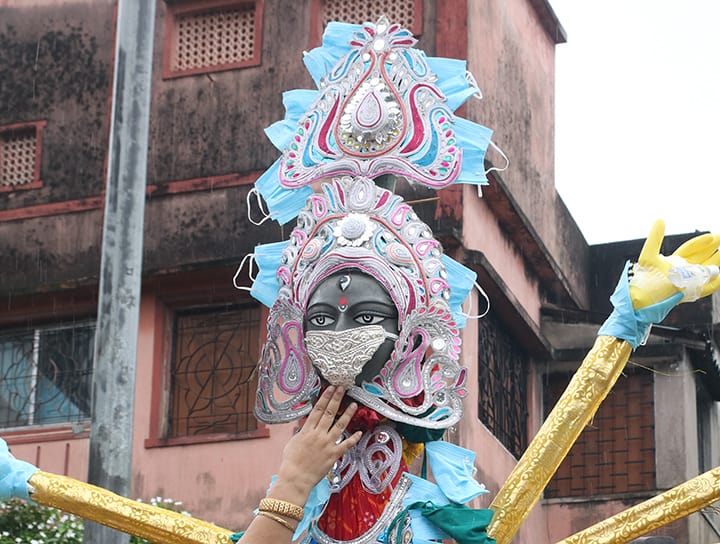The Coronavirus lockdown has resulted in a shrinking of the economy, which has impacted Durga Pujas as well. While artisans and organisers face the heat, some are coming up with unique ways to handle the new normal
Swapan Pal is sitting in front of his workshop in Kumartuli sipping a cup of tea as he gives finishing touches to a Durga idol. He says that nowadays he finds a lot of time to sit around for his lunch and tea breaks. Unlike previous years, when he was always in a hurry and hardly found time in the afternoons to have his meal.
This time last year, with less than two months till Durga Puja, the artisan at Kumartuli would be on his feet the whole day, with rows of idols awaiting finishing touches and labourers moving around in a frenzy. The scene this year is completely the opposite.
With the festivities less than two months away, Kumartuli — the idol-making hub in North Calcutta, which hustles and bustles with action in the run-up to the festivities, bears a dreary and gloomy atmosphere. Orders for Durga idols have sharply declined when compared to previous years as most studios are empty and the rush to complete the idols in time is completely missing.
Artisans believe Covid-19 blow has landed them in the worst financial crisis in at least the last 50 years.
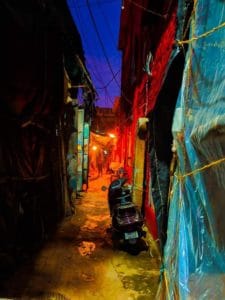
Kumartuli has so far received orders for Durga Puja idols worth less than Rs 15 crore, artisans say. Last year, it had received orders worth around Rs 50 crore. This means that business this year is just 30% of last year.
Last year too, business was lower than expected. Several big pujas had to curtail their budgets owing to the downward slump in the economy.
“Last year was bad compared with previous ones. But nothing like this time. Organisers are not even turning up to book idols. The ones that are calling up are seeking idols for half last year’s price,” said Babu Pal, the secretary of the Kumartuli Mritshilpi Sankritik Samity.
The organisers that had last year bought idols in the price range of Rs 60,000 to Rs 70,000 are unwilling to pay more than Rs 25,000 this year.
Every year, more than 2,000 community pujas buy idols from Kumartuli. The bulk of the bookings are done by July, latest by mid-August. Committee members would turn up in large numbers and scan idols across studios before finalising their orders.
The goddess would usually be at least 12 feet tall. “This year organisers are looking for idols that are 6-7 feet high,” said Ashok Pal, an artisan. In fact, this year also saw an order of a 2.5 foot idol — the shortest by any standard, to be sent to Sweden.
Fewer orders and shorter idols mean less work for assistants and helpers at Kumartuli, majority of whom come from the districts of Nadia, Howrah, East Midnapore, and North and South 24-Parganas.
“Kaaj i nei (There is no work),” said Ram Sikdar (name changed), a seasoned hand among the assistants. “I have been hopping around studios all over the city looking for work. It’s unthinkable to receive so little work during this time.
Hailing from a small village near the Sundarbans, Sikdar’s house was completely damaged during the Amphan cyclone. “I planned to spend the money I would get this year to rebuild my house, but with so little earnings, it looks absolutely impossible.”
Generally, workers like Sikdar would get paid between Rs 10,000 to Rs 30,000 a month this time of the year, depending on their skill sets. “So far, I have received work worth Rs 3,000 in the last two months,” he adds.
Currently, around 700 of these workers are now engaged in Kumartuli. And people like Sikdar are waiting in eager anticipation for the pandemic to end, and life to return to normal.
Apart from assistants and helpers, a large number of labourers would turn up at Kumartuli around the time idols were to be taken to pandals. Most of them are residents of the Sundarbans, Canning, Baruipur, Joynagar and their adjacent areas in South 24-Parganas.
Each group of labourers would take Rs 5,000 from an organiser to carry the idols from a studio to the pandal and place them on their perch.
“They would turn up in groups of 25-30 each and around 100 such groups would arrive at Kumartuli just before Puja,” said Ramesh Pal, an artisan. “They would stay back, going home only after the immersion.”
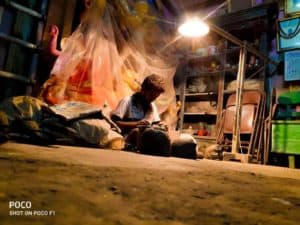
This time, around six or seven groups have said they would come despite the risk of the Coronavirus. The rest are not sure about what to do.
Each artisan in Kumartuli depends heavily on different sets of people for their supplies of straw, mud, bamboo, dress materials and ornaments. Suppliers bring the items from East and West Midnapore, Burdwan, and North and South 24-Parganas. Bamboo is mostly sourced from Murshidabad and Nadia.
Last year, ornaments worth around Rs 3.75 crore were used to deck out the idols. A family of four usually works on different kinds of ornaments and dress materials. Around 400 families work on thermocol ornaments.
“A majority of them are left without any order this year. The orders that have come add up to a little over Rs 1 crore. Imagine the slump,” says Babu Pal.
A grand festival no more?
The Covid-19 pandemic and the resultant lockdown is going to result in a muted Durga Puja celebration in Kolkata this year, but the pandals are not being cancelled.
A representative from The Forum for Durgotsab, the city-based organisation that oversees all sarbojanin or community Durga Puja pandals in the Kolkata metropolitan area, dismissed reports that there would be no pandals due to the Coronavirus outbreak.
In the Kolkata metropolitan area, there are approximately 400 big pandals constructed every year, in addition to countless smaller neighbourhood pandals.
“Major Puja organisers in the city have informally decided that Pujas will be organised on a smaller scale. But they will not be cancelled” he says.
In West Bengal, Durga Puja has become heavily commercialised over the years. This is not just a religious festival but a big industry with big income attached, from people shopping for clothes to the musicians who play the dhaak.
A 2019 report by an advertising organisation, ‘Brand and Beautiful’, said that total corporate spending in Durga Puja amounts to Rs 500-800 crore, with advertisements accounting to nearly Rs 150 crore. But this year, with the GDP falling into the negative, the impact on Pujas will be huge.
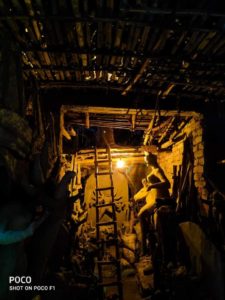
Lockdown orders by the Central government have impacted celebrations of major festivals like Eid, Ganesh Chaturthi and Muharram where people were unable to step out of their homes for rituals and engage in their customary meetings with family and friends. So, the lockdown is likely to affect Durga Puja celebrations too.
Organisers believe West Bengal-based enterprises and companies that usually sponsor the pandals may not give Puja committees as much money as they usually do because of the economic impact that they themselves are facing post lockdown.
“We have gotten feedback from sponsors that they don’t know how much money they’ll be able to give us this year because their first-quarter income has been impacted,” says Amitava Ray, member of the Forum and organiser of Hatibagan Nabin Pally, one of North Kolkata’s biggest pujas.
“We are facing budget cuts and we have given money from our puja budget to the CM Relief Fund for Coronavirus and we may give more in the future. So we will have a pandal but we will curtail our spending. We know that our sponsors will not be able to give us enough money for the pandal this year. As of now, we still have plans to go ahead with our plans for Durga Puja,” said Pratik Chaudhuri of Dum Dum park Bharat Chakra.
“If the government makes a decision due to Coronavirus, then we’ll do the pujas in a very small way. Durga Puja has always happened here and the government has always been involved. So we will see what they say and maybe organise it by maintaining social distancing between visitors,” says Ray.
Drive in Darshan (BOX)
With the introduction of the new normal in a post-Covid world, Durga Puja organisers are trying their level best to come up with new ideas for a safe visit to their pandals.
Three Durga Puja committees in the city, all crowd- pullers and located within one-km stretch in south Kolkata, have joined hands to introduce a drive-in ‘darshan’ concept — an arrangement which would allow people to slow down their car to take a look at the pandal and the Durga idol without having to alight from their cars.
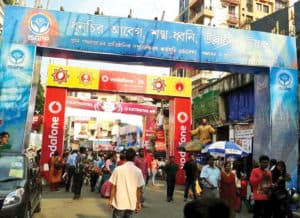
“As maintaining physical distance is mandatory, we had to think of a concept that would avoid crowding near the pandals. Our patron, Texas-based Mridul Pathak, came up with this drive-in concept during a video conference. Shortly after, we set the ball rolling,” Kapil Dev Pathak, an officer-bearer of Badamtala Puja committee, said in a press statement
Sanitiser will be sprayed on the cars before every pandal,
The drive-in route has been mapped in such a way that people will get to catch a glimpse of the Badamtala puja decoration, before proceeding westwards to 66 Pally, and finally the Nepal Bhattacharya Street Durga Puja at the end of the trail
The organisers have decided to pay tribute to director Satyajit Ray this time, he said.
“As this year marks Ray’s birth centenary, we the chose Apu trilogy as the theme for the three marquees. Badamtala will portray scenes of ‘Pather Panchali’, 66 Pally of ‘Aparajito’ and Nepal Bhattachaya Street Pujo will depict ‘Apur Sansar’,” he added.
(Cover image credit: Getty Images)

